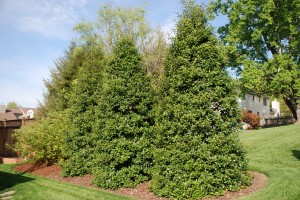I continue to witness the overplanting of Leyland cypress (Cupressocyparis x leylandii) across the Southern Appalachian region (USDA zones 6 and 7). This is followed by Japanese cedar (Cryptomeria japonica) and western arborvitae (Thuja x plicata). These three evergreen species have a rapid growth rate and eventually attain heights of 40-60 feet, sometimes in less than 20 years. Ask yourself the question: “do you really need a huge green barrier around your property?”
Hollies offer the benefits of lustrous green foliage and colorful fruit. The following evergreen species create a dependable privacy screen: Dwarf Burford holly (I. cornuta ‘Dwarf Burford’), Inkberry (I. glabra), American holly (I. opaca), Foster #2 holly (I. x attenuata), and Nellie R. Stevens holly (I. x ‘Nellie R. Stevens’).
A few simple tips about growing hollies:
- Hollies prefer a slightly acidic, well-drained, and organically rich soil.
- Hollies prefer full to partial sun location.
- Established hollies demonstrate good drought tolerance.
- Space plants a minimum of 12 feet apart.
- Hollies should be properly mated. Fruit are produced on female cultivars and a matching male pollinator should be planted.


 Posted in
Posted in 
